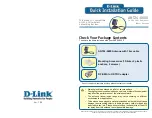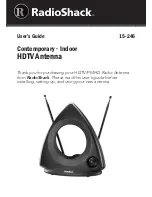
Please Note:
A qualified structural engineer
should be consulted prior to mounting an
antenna on a tower or support structure.
BREAKING DOWN BUNDLE
1.
Remove the 8 ft. mast, the three 4 ft. base stubs and the package of nuts, bolts and wash-
ers.
2.
Lay the bundle on its side and remove tower sections. Start with DMX1 section (smallest
section) and remove by pulling out with quick, firm jerks. It is not necessary nor desirable to
pry sections out with tools.
3.
Inspect all tower sections on delivery to make sure there are no loose or broken rivets
caused by transport mishandling. If a rivet is broken or loose, it should be replaced by a
snug-fitting machine screw and nut securely tightened.
SETTING THE BASE IN CONCRETE
1.
We recommend that a square hole be dug 1.2 m deep and 1.67 m square.
2.
Fasten the 4 ft. base stubs to the outside of the tower base section. Insert a 1/2 inch bolt or
rod about 1 inch long (not supplied) through each hole in the bottom of the base stubs to
prevent the stubs from pulling out the concrete.
3.
Place the bottom tower section with base stubs attached into the hole and hold in a vertical
position while concrete is poured in. Level the concrete even with the bottom of the base
section.
NOTE:
Since the three legs taper in about 1 degree, check each leg so they are all the
same angle using a long level as shown at right.
NOTE:
If the tower is being placed in loose soil, be sure to check with a local
building contractor for advice on installing a deeper or larger base. This tower is no
stronger than the base itself. (Assumed soil 190 KPA or 4000 PSF.)
ERECTING TOWER
After the concrete is hard the tower is ready to be erected. We recommend the use of a “gin-pole”
similar to the drawing on page two. The gin-pole is 15’ long and hooks into the “X” braces and strad-
dles the tower leg. The rope which runs through the pulley is attached to the next tower section a bit
above the centre of the section. A man on the ground can pull the section up and the man on the
tower guides it into the top of the lower tower section. Special stop rivets prevent the upper section
dropping too far inside. After the bolts and nuts are securely tightened the gin-pole can be unhooked
and raised to the top of the next section and so on until the tower sections are all installed. The gin-
pole is handy for installing the antenna and mast. A strong safety-belt should be worn when climbing
the tower for assembly or antenna adjustments. Gin-pole will fit from DMX1 to DMX6 sections.
HUB HINGE-UP BASE FOR DMX TOWERS
1.
Assemble the 3 legs of HUB and tighten all bolts and nuts securely. The threaded end of
each long rod should not protrude more than 1/8” beyond nut or hinge — tube may catch on it
when hinging.
2.
Bolt HUB tubes on the INSIDE of each leg of bottom tower section. Make sure hinges all face
the same direction.
3.
Bent ends of legs are positioned away from each other.
4.
Dig base holes as outlined on this sheet above.
5.
Place tower section, with HUB attached, into hole and hold it in a vertical position while con-
crete is poured in. Level concrete even with bottom of the lower nuts. Check all three legs
with a level to make sure they all tilt the same (about 1 degree).
6.
Wooden tower supports can be placed under the legs to hold them in position. Shims made
from thin metal can be driven under legs until tower section is absolutely level on all three
legs.
7.
Make sure two legs are away from the building or the tower will not hinge up.
8.
A block and tackle can be used to pull tower up.
9.
We recommend installing a safety anchor to prevent the tower from toppling.
Instruction Sheet
390348 Rev. E
Ontario, CANADA
www.wadeantenna.com
INSTALLATION INSTRUCTIONS FOR SELF-
SUPPORTING DMX, DMXMD, DMXHD CONCRETE
BASE TOWERS
HUB Hinge-Up Base
Top view of
base
Wood leg
support
1/2” bolt or rod
1/4”
spacer
taped
to level
Level
DEPTH
1.2m
22”
WARNING
Survey your installation site NOW to prevent your
antenna or support from coming in contact with
overhead powerlines.
FAILURE TO EXERCISE THIS CAUTION
CAN CAUSE ELECTROCUTION
3.34 cubic m Width: 1.67 m Depth: 1.2 m
BASE STUBS
IN CONCRETE
NTS
WIDTH = 1.67m
The recommended concrete base for installers who use “Ready Mix” concrete:
CAUTION: SHARP EDGES—WEAR GLOVES




















